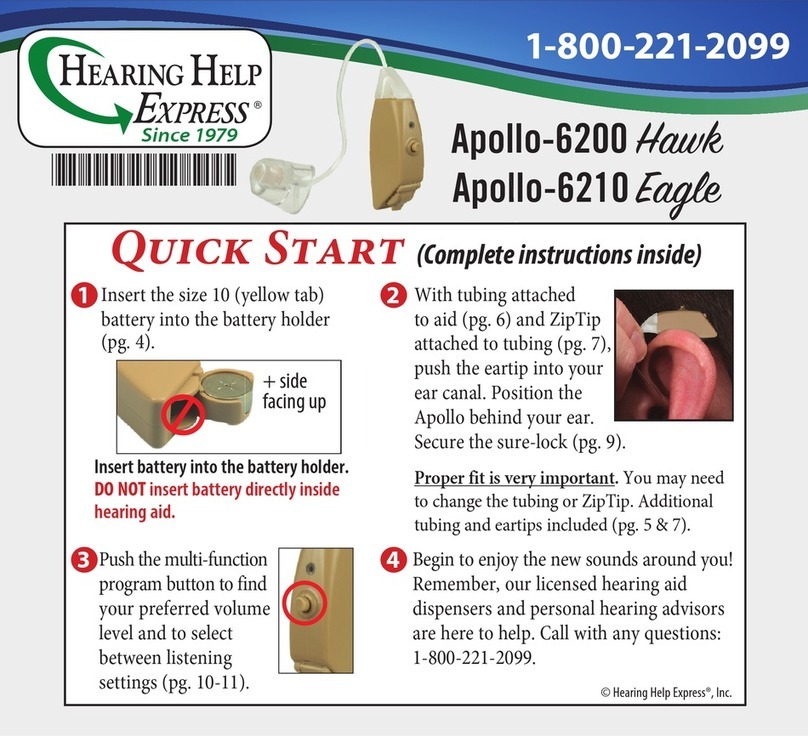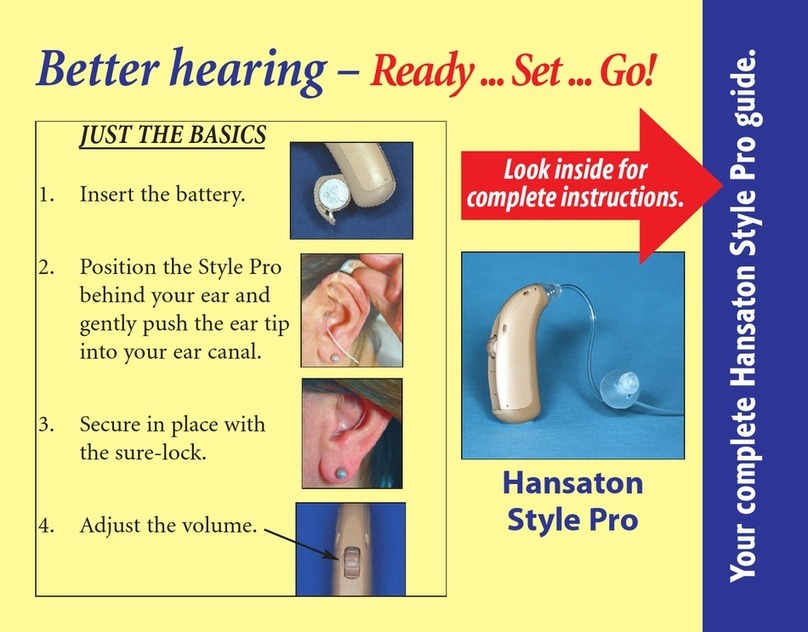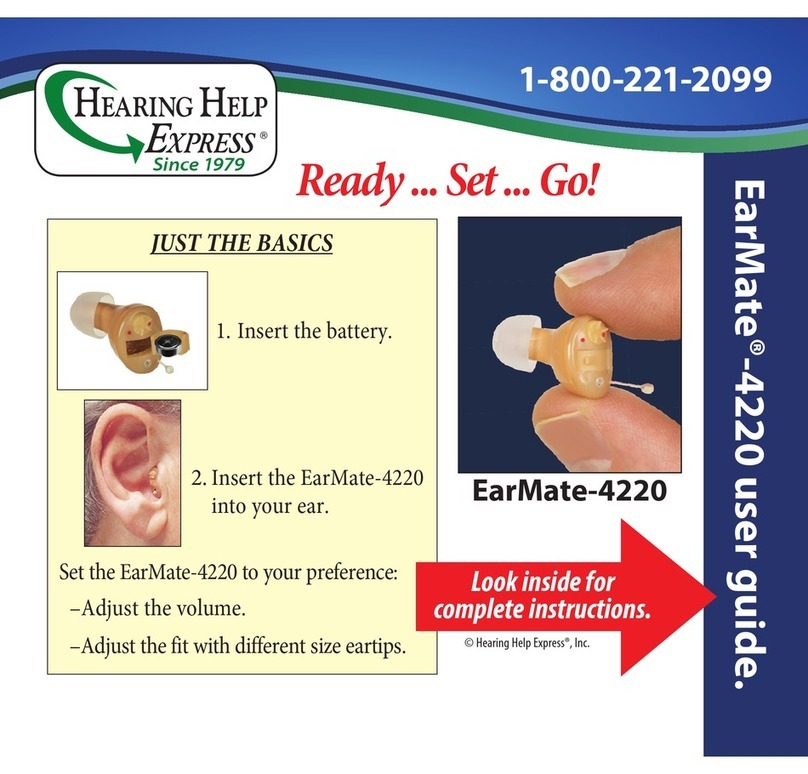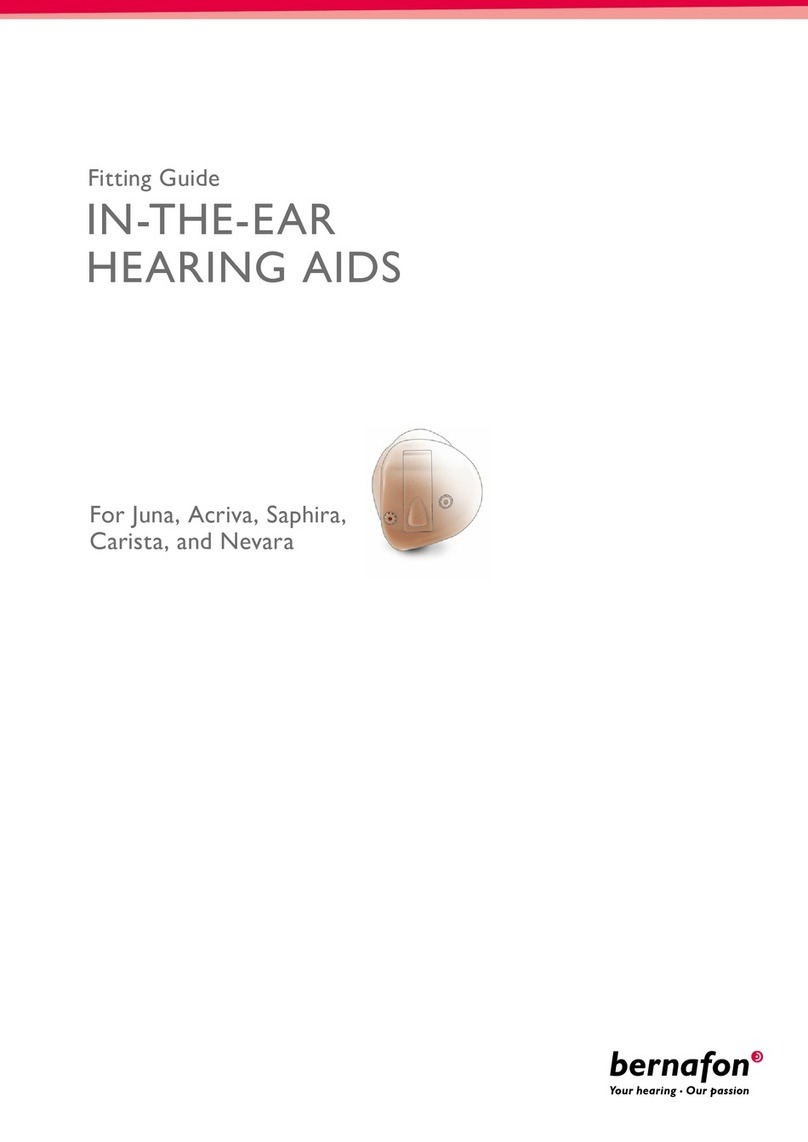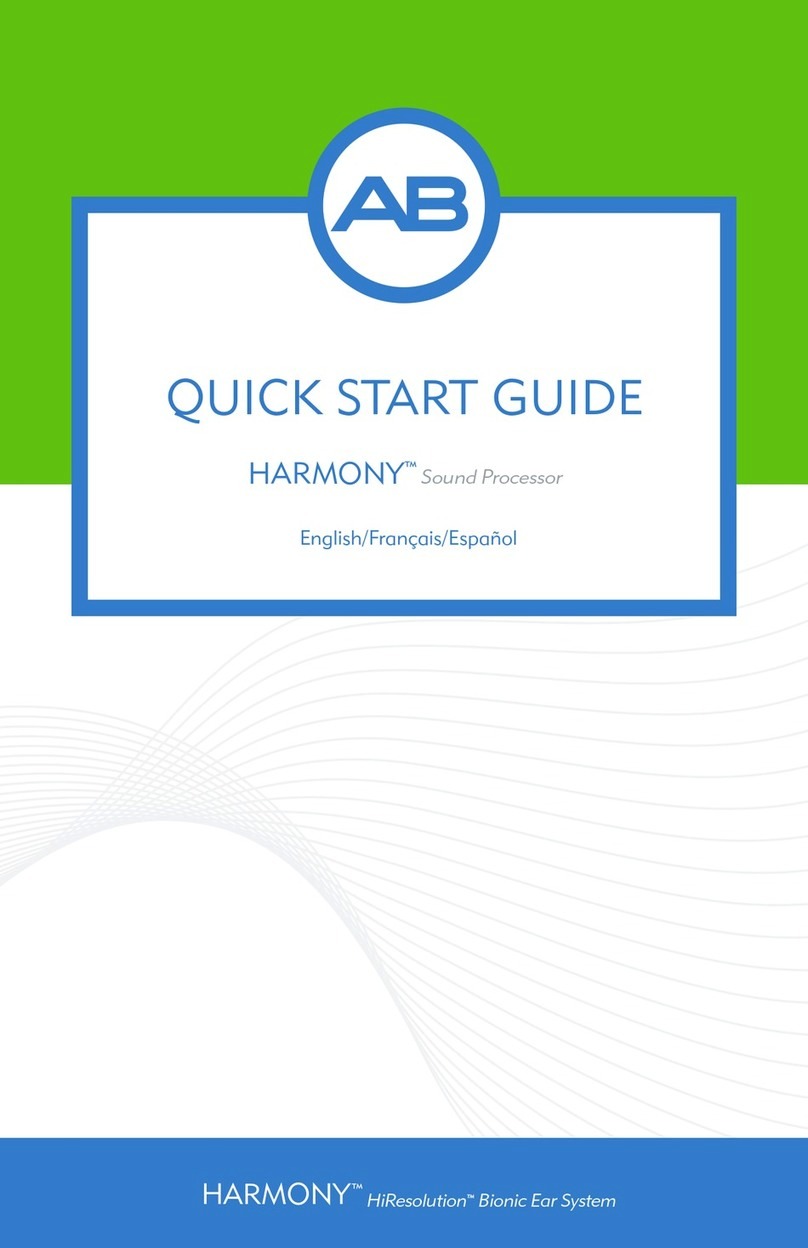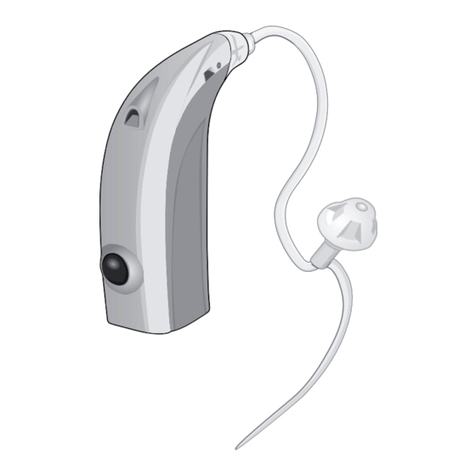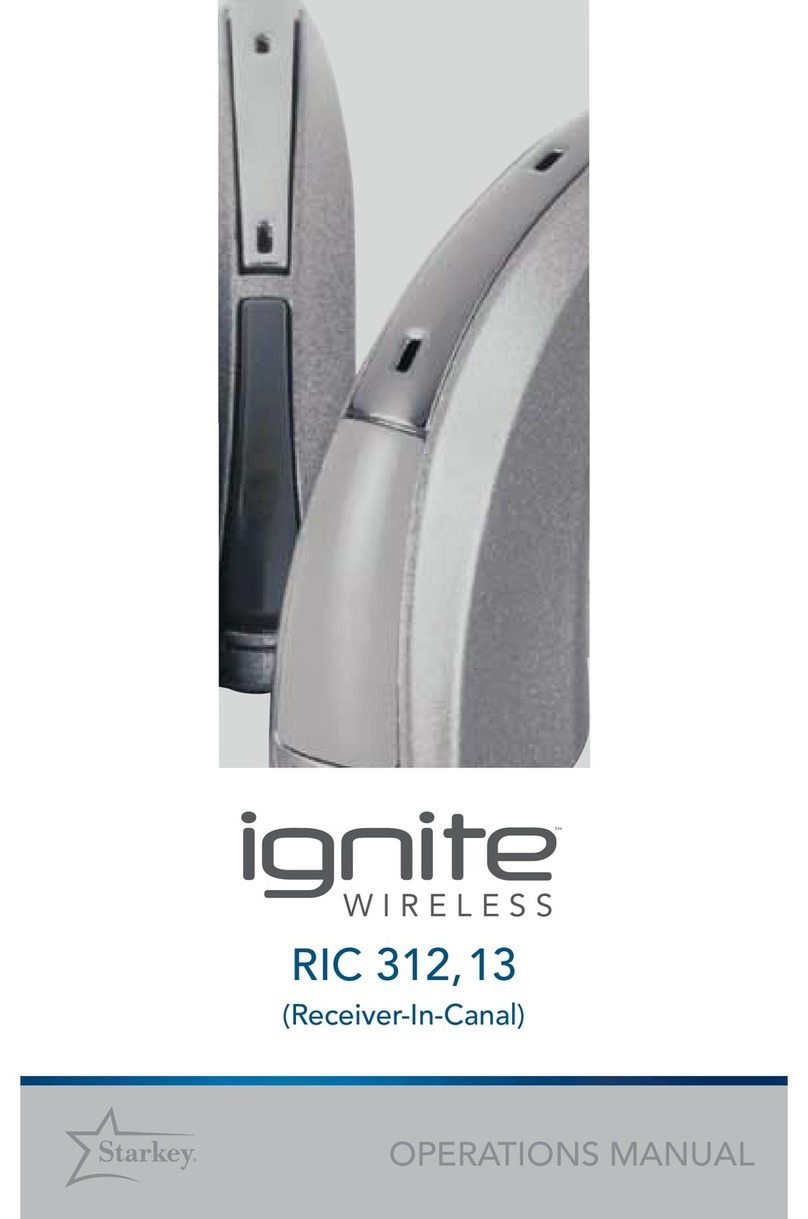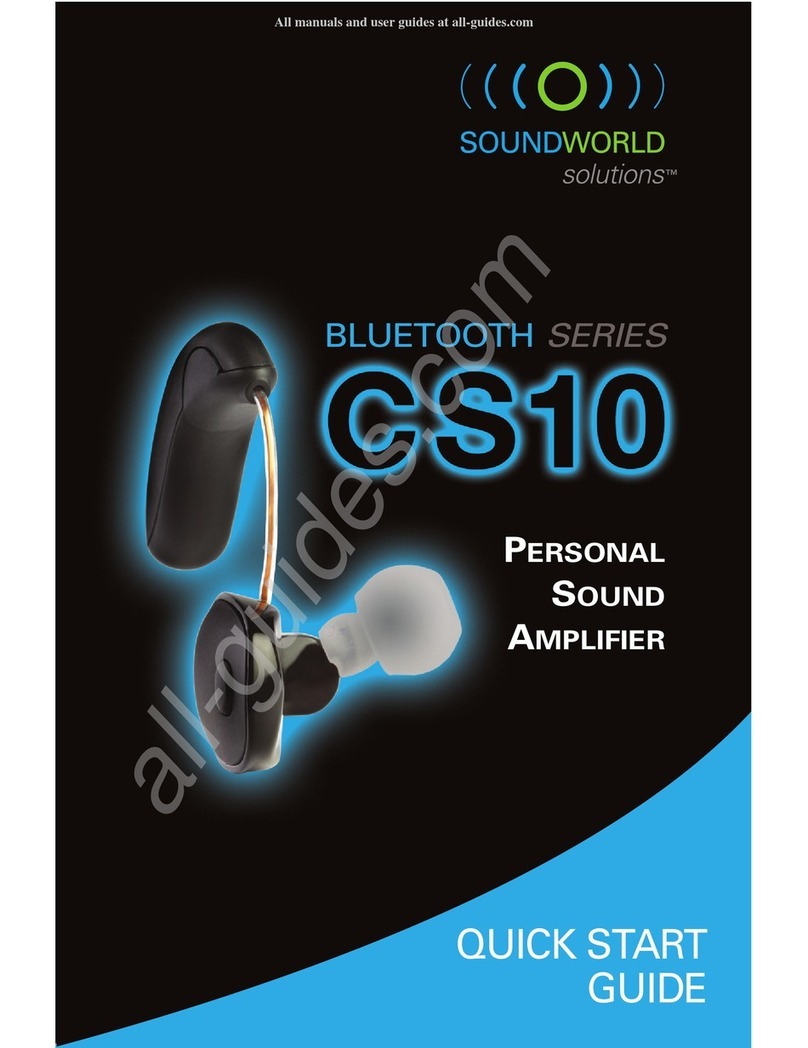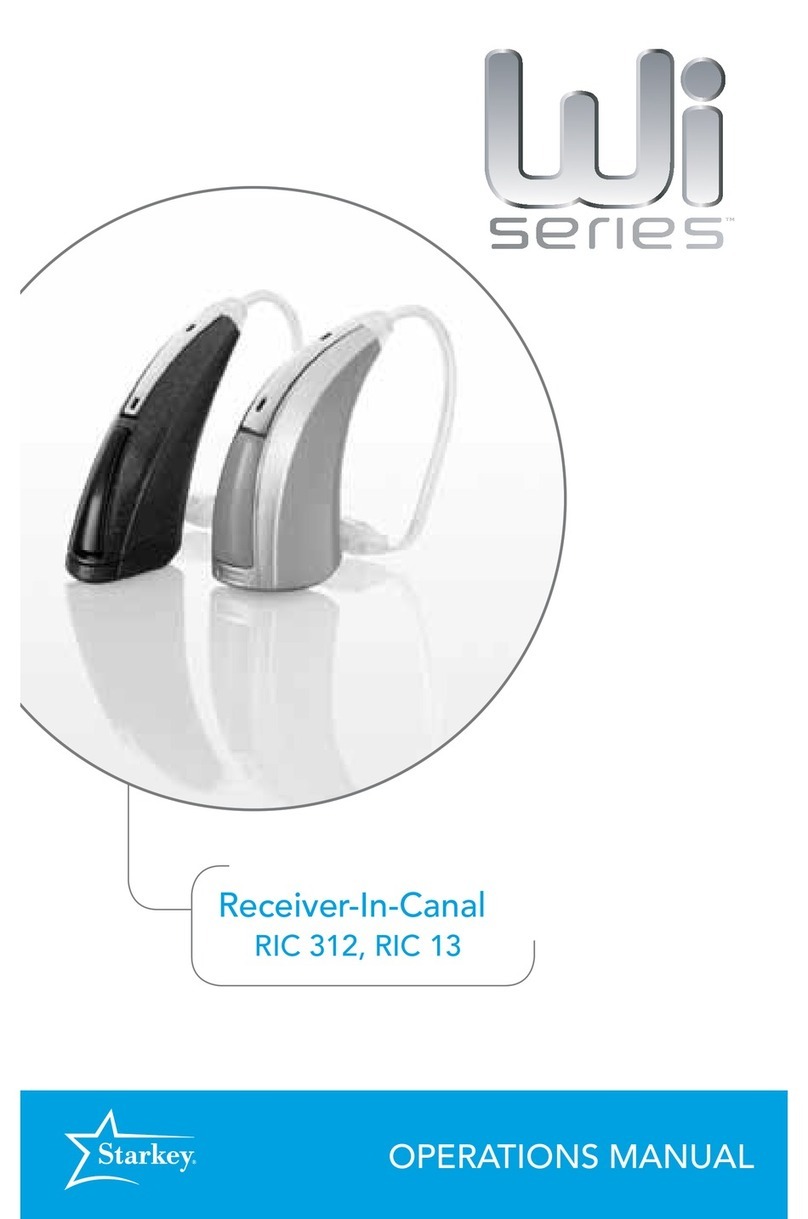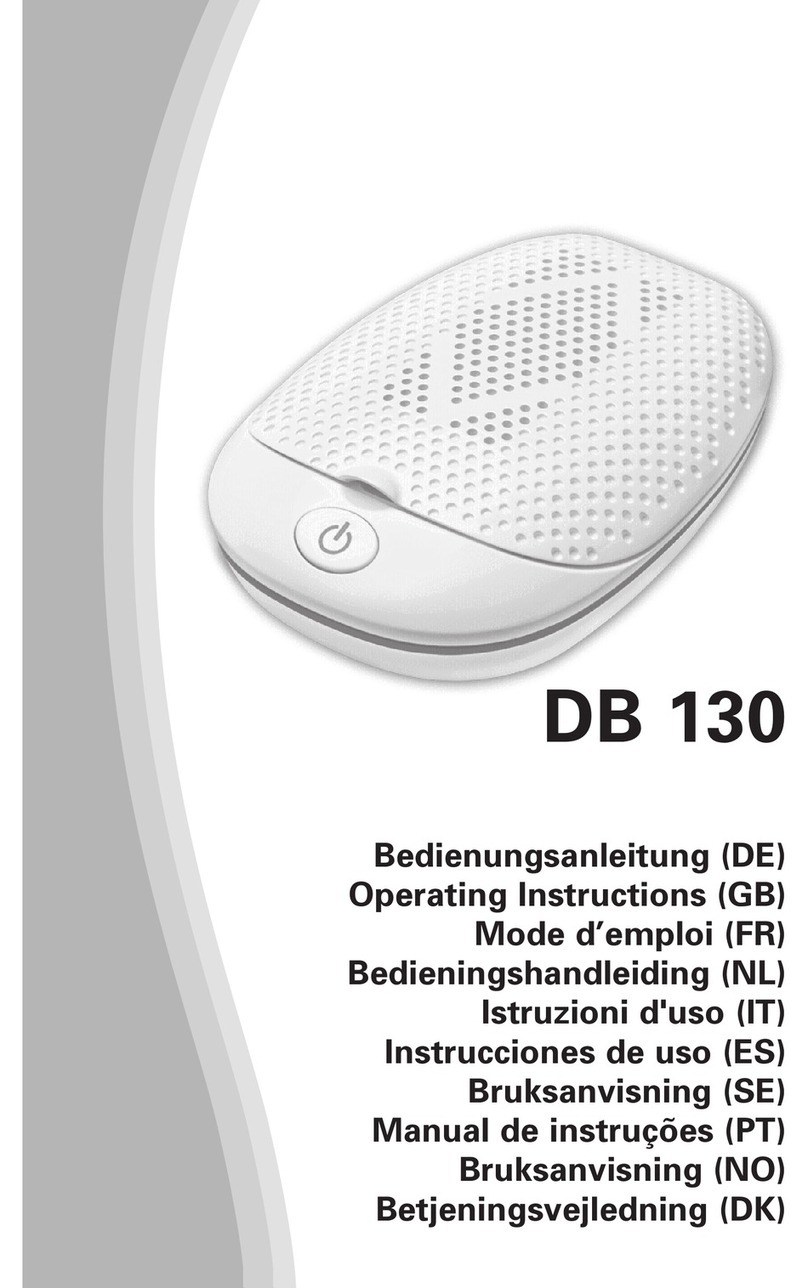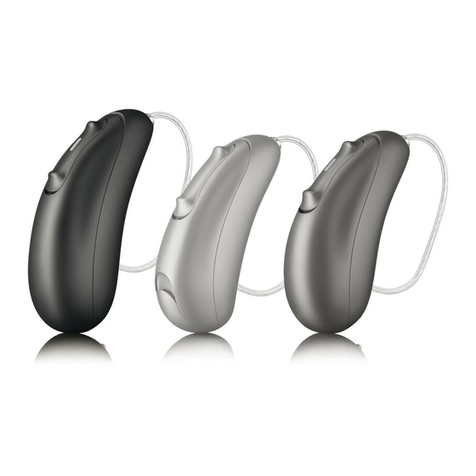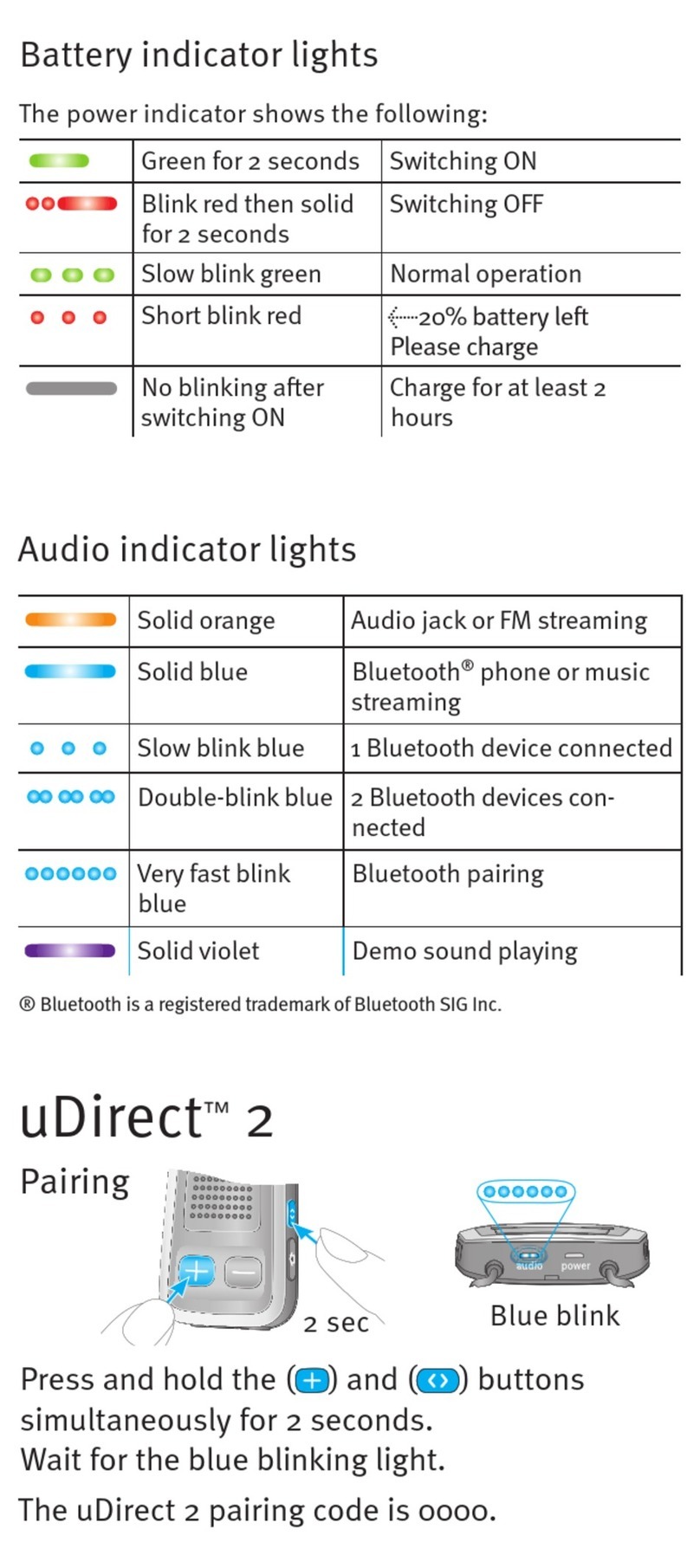Hearing Help Express Ranger-7600 User manual

Since 1979
1-800-221-2099
*360180110*
Insert the size 13 (orange tab)
battery into the battery holder
(pg. 5).
Ranger-7600 (Energy)
User Guide
Ranger-7600 (
Q S (Complete instructions inside)
Insert battery into the battery holder.
DO NOT insert battery directly inside
hearing aid.
Place the Ranger-7600
behind your ear (pg. 9).
Proper fit is very
important. You may need
to change the ZipTip.
Additional ZipTips are included (pg. 6).
1 3
Measure, cut and attach the
tubing (pg. 7).
2
Rotate the volume wheel to
find your desired volume
level (pg. 10).
4
Push the multi-memory button
to select your preferred listening
setting (pg. 10).
5
© Hearing Help Express®, Inc.

21 Day Hearing Journey
2
Yes, you get a full 45 days to try your Hearing Help Express
hearing aid but THE FIRST 21 DAYS ARE THE MOST IMPORTANT.
Hearing aids are not like wearing glasses – they don’t repair your hearing,
they assist what hearing you have left. Getting used to hearing aids is a
gradual process that takes time and patience as you learn to hear familiar
sounds again. Start slowly by wearing your hearing aids for 30 minutes and
gradually build up to wearing them all day.
At first some sounds will seem too loud, this is because your brain is
relearning how to prioritize sounds. After about a week, listening will
become easier and conversations will become clearer. Continue to practice
by watching your favorite TV program or listening to your favorite music.
Around week three you will begin to feel more energized because your brain
isn’t working as hard to prioritize sounds for you and finally by day 21, you
will be enjoying a world of better hearing!
We’re always available by phone, chat, or email to help you through this journey!
Your success is our success.
Since 1979
45-DAY
RISK-FREE
HOME TRIAL
Licensed hearing aid
dispensers on staff

2
3
4
5
6
7
8
9
10
11
12
13
14
15
16-17
18-19
20
21-23
24
Table of Contents
1714 Sycamore Rd • PO Box 586 • DeKalb, IL 60115
Questions, call toll-free: 1-800-221-2099 3
21 Day Hearing Journey
Table of Contents
Ranger-7600 Parts Identified
How to Insert the Battery
ZipTip and Tubing Options
How to Attach the Tubing
How to Tell Right from Left
Inserting & Removing Ranger-7600
Volume Control & Listening Settings
Helpful Tips
Care and Cleaning
Important Care Instructions
Troubleshooting & Service
Service Plans
Technical Data
Additional Information
Custom Earmolds
Accessories
Warranty
Since 1979
All prices subject to change.

Ranger-7600 – Power Level 6
Battery Size: Your Ranger-7600 uses a size 13 (orange tab) zinc-air battery.
Serial Number: Located on the outer shell of the Ranger-7600.
1. Earhook
2. ZipTip with tubing
3. Microphone
4. Volume control
5. Multi-memory
push button
6. Battery holder
5
1
2
Ranger-7600 Parts Identified
4
3
4
6
On
With a battery
installed, close the
battery holder to
turn the Ranger on.
Open the battery
holder to turn the
Ranger off.
Off

How to Insert the Battery
5
LOW BATTERY INDICATOR: When the battery is no longer strong enough
to power your Ranger-7600, you will hear 3 double beeps every 8 minutes.
This will repeat until you replace the battery.
1. Remove the orange-colored tab from the flat, (+) positive side of the size
13 battery. Wait one minute for battery to reach full power before using
(or testing) battery.
2. Open battery compartment gently, using your fingernail or
thumbnail. Pull out on the small lip of the battery holder
located on the lower part (below the multi-function push button).
3. Once the battery holder is open you will see a small +symbol on the top
rim of the battery holder. This indicates that the flat, positive side
of the battery should face in the same direction as the +symbol.
4. Place the battery in the battery holder.
5. Close the battery holder. NEVER force the battery holder closed. If the
holder does not close easily then the battery is probably upside down.
thumbnail. Pull out on the small lip of the battery holder
++ (positive ) side
of battery faces up
+ symbol on
battery holder
DO NOT place the
battery directly inside
the hearing aid.
How to insert the battery

ZipTip and Tubing Options
6
Your Ranger-7600 hearing
aid comes with 2 ZipTips
with tubing.
Included with your order:
• Size Small ZipTip with small vent (try this ZipTip first)
• Size Small ZipTip with no vent (try this ZipTip if you have
trouble with feedback/squeal)
If you have trouble with the fit of the ZipTip, give us a
call and we will send you a Size Medium to try. You may
also want to consider trying a custom earmold (pg. 20).
ZipTip with tubing options:
Left Ear
ZipTip with tubing – $10.00 ea
Small no vent #86001
Medium no vent #86003
Small with vent #86011
Medium with vent #86013
Right Ear
ZipTip with tubing – $10.00 ea
Small no vent #86002
Medium no vent #86004
Small with vent #86012
Medium with vent #86014

How to Attach the Tubing
7
1
2
3
How to attach the tubing:
Put ZipTip and Ranger-7600
in place
1. Place the ZipTip with attached
tubing in your ear and the
hearing aid over your ear.
CUT OFF EXTRA TUBING
2. Observe where the tubing overlaps
the earhook and mark the tubing
leaving an 1/8 to 1/4 inch overlap.
Cut off any extra tubing.
3. Insert the tip of the earhook into
the tubing. If it is hard to insert,
warm the tip of the flexible tubing
with hot water. Wipe dry before
inserting.

How to tell your right Ranger-7600 from
your left Ranger-7600:
Behind-the-ear hearing aids can be used on either ear but
the ZipTips are specifically made to fit either the left or right
ear. (Once you have attached your ZipTip and tubing to your
hearing aid it is then set specifically for either your right or
left ear.) The sound opening on the ZipTip will “point” away
from the Ranger-7600.
• Left ear: sound opening “points” right
• Right ear: sound opening “points” left
Set for
left ear.
Set for
right ear.
How to Tell Right from Left
8
Questions, call toll-free:
1-800-221-2099
Since 1979

Inserting and Removing
9
How to insert the Ranger-7600:
1. Hold the tubing behind the ZipTip
and insert the ZipTip into your ear.
If using a custom earmold, make sure it is
correctly positioned in your ear. The top and
bottom of the earmold should fit securely.
2. Place your Ranger-7600 behind your
ear by slipping it over the top of your ear.
Some people prefer to first place the
Ranger-7600 over their ear and then insert
the ZipTip. Experiment and find what
works best for you.
How to remove the Ranger-7600:
Reverse steps 1 and 2 when removing the Ranger-7600
hearing aid.
1
2

Volume Control / Listening Settings
10
Volume Control:
Adjust the volume up and down by rotating the volume control wheel.
The higher the number, the more amplification.
Note: Feedback is a whistling or squealing sound that
hearing aids can make. Feedback can be caused by a
hearing aid being set too loud. If you experience feedback,
reduce the volume slightly or try the ZipTip without a vent.
Choosing your Listening Settings:
You have 4 multi-memory settings to choose from.
When turned on, your Ranger-7600 will be on setting 1.
Simply push the button to choose the setting you need.
Setting 1: Normal setting – 1 beep. Use in most
listening situations.
Setting 2: Noise setting – 2 beeps. Reduces the amount of low
frequency amplification. Often helpful in noisy situations.
Setting 3: Whistle reduction –3 beeps.Use if your Ranger-7600
whistles or if sounds seem too sharp or tinny.
Setting 4: Telephone setting – 4 beeps. Use when talking on the
telephone or with a loop system. Hold the telephone receiver as
close to the hearing aid as possible. You will only hear sounds from
the telephone or loop system.

Helpful Tips
11
1. Start Slowly – Begin by using your new
hearing aid a few hours a day while you are
alone. If you are not used to wearing a hearing
aid, you will probably notice many sounds you
have not heard in a while. Crackling paper
may be surprisingly loud. Other sounds like the
refrigerator or air conditioner may feel uncom-
fortable. With time you should be able to focus
on the sounds you want to hear. Hearing aids
will not restore your old hearing, but with time and practice, they can help.
2. Read Out Loud – Your own voice will sound different to you. Try reading
out loud for 15 minutes a day to get used to the sound of your own voice.
3. Practice Listening to One Voice – Start in a quiet environment listening to
the radio or your favorite TV show. Then practice listening with one friend or
family member at a time.
4. Listen and Talk in Small Groups – Next try talking with a small group
of friends or family members in a quiet setting. Crowded places such as
restaurants or churches are likely to have more background noise that can
interfere with your understanding. Remember, it is difficult for most people
to understand in these situations. So, be patient and keep practicing. Your
understanding should improve with time.
Helpful Tips

Care and Cleaning
12
Care and Cleaning
We’ve done what we can to protect your Ranger-7600 from
moisture and earwax but a little regular cleaning by you will go
a long way towards trouble-free use. Without regular cleaning,
wax and moisture can build up and prevent your Ranger-7600
from working properly. We suggest cleaning your Ranger-7600
in the morning before you use it and storing it overnight in
a DryAid Dehumidifier (pg. 21). For best results consider
purchasing the Cleaning Care Plan (pg. 15).
Cleaning your Ranger-7600:
1. Wipe off the outside of the Ranger-7600 and the
ZipTip with a soft cloth or hearing aid cleaning
wipes (call to order).
2. Gently brush across the
microphone openings using
the enclosed cleaning brush.
Questions? Call 1-800-221-2099
Cleaning
Brush

Important Care Instructions
13
IMPORTANT CARE INSTRUCTIONS
BEGINNING THE DAY:
After showering, apply
all lotions, creams,
hairspray, perfume
and cologne BEFORE
putting on your Ranger-7600s. Water and such sprays can damage
hearing aids. And please remember, your hearing aids are sensitive
and don’t like extreme heat or cold. Never place your Ranger-7600
in water. If it becomes wet, immediately remove the battery and let
your Ranger-7600 stand in a dry place or DryAid dehumidifier (pg. 21)
for several hours. NEVER use heat (blowdryer, oven, microwave, etc.)
to dry your Ranger-7600.
AT THE END OF THE DAY: Open the battery door when not
wearing your hearing aid. Any moisture inside your hearing aid
can then evaporate, extending the life of your Ranger-7600. With
the battery door open, you can be assured your hearing aid is off
and not squealing. A squealing hearing aid can attract pets which
have been known to chew on hearing aids and damage them
beyond repair. Even better, remove the battery and store your
Ranger-7600 overnight in a DryAid dehumidifier.

Troubleshooting & Service
14
If your hearing aid is: WHISTLING (FEEDBACK)
If your hearing aid is: WEAK, DISTORTED, DEAD
If your hearing aid requires service, send it to:
Hearing Help Express • 1714 Sycamore Rd • PO Box 586 • DeKalb, IL 60115-0586
1. Turn the volume down, it may be set
too high (pg.10).
2. Use listening setting #3 (pg. 10).
3. Check that your ZipTip is inserted
correctly (pg. 9).
4. Try the ZipTip with no vent or call
customer service for other options.
5. Verify that the tubing is attached
correctly and is both soft and in good
condition. If the tubing has hardened
or is damaged, it should be replaced
(pg. 7).
6. Your Ranger-7600 may briefly whistle
when a hand, hat or other object is near
it or when inserting and removing.
1. Check that the battery is inserted
correctly (pg. 5).
2. Try a fresh battery.
3. Clean your Ranger-7600, microphone
port and ZipTips (p. 12).
4. If your Ranger-7600 goes dead
periodically, but comes on after several
hours of rest, the problem may be a
build-up of humidity. Try storing it
in a DryAid dehumidifier when not in
use. Call toll-free to order (pg. 21).
1. Call 1-800-221-2099 for authorization
before returning your aid for repair.
2. Enclose a note with your name, address,
phone number and a description of
what is wrong with your hearing aid.
3. Pack your hearing aid securely in a sturdy
box. (Do not mail hearing aids in an
envelope, they could be destroyed
during shipping!) We recommend
insured mail or UPS for your protection.

15
Service Plans – Protect your hearing investment
P
R
O
T
E
C
T
I
O
N
G
U
A
R
A
N
T
E
E
D
C
L
E
A
N
I
N
G
C
A
R
E
P
L
A
N
Protection Plan – One year of worry-free hearing aid repairs or replacements! (Call for price)
•Act Now! - e optional Protection Plan is available for purchase for up to 90 days
from the shipment date of your hearing aid(s).
•Get PROTECTED - Water, droppage, step on it - You name it! We will x or
replace it at no additional charge for one year (loss or the are not covered).
•Comprehensive Coverage - is plan goes above and beyond the limited manufacturer’s
warranty. We will repair any damage or send a replacement hearing aid if we can’t x
it at no extra charge to you.
•Simple Process - Call ahead to get authorization to send us your broken aid. Once received, we
will diagnose, repair or replace it in just a few days. Loaner hearing aids are available for $15 each.
Cleaning Care Plan – Get the MOST out of your Hearing Aids ($149.99 each)
•Maintain Optimal Hearing Performance - Today’s hearing aids are lled with
sensitive electronics to give you the best experience possible. Over time earwax and
moisture can tamper with those electronics and the performance of your aids may suer.
Choose the Cleaning Care Plan to have your aids cleaned and serviced by our team of in-house
technicians to make the most out of your hearing aids.
•Extend the Lifetime of Your Aids - e Cleaning Care Plan oers up to four yearly cleaning
services. Simply call when you're ready for service. Our customers who have their hearing aids
cleaned by our technicians replace their hearing aids less frequently than those that do not.
•Our Process - Up to 4 times per year we will send you loaner hearing aids in a box with prepaid
postage to send your aids to us for service. Our technicians will professionally deep clean your
aids and replace tips or tubing if necessary . Once the service is complete we will return your
hearing aids in another prepaid box and you mail the loaner aids back to us. It’s that simple.

Technical Data
16
Ranger-7600 Technical Data
Maximum SSPL90
HFA SSPL90
HFA full-on gain
Reference test gain
Frequency range
Equivalent input noise
Total harmonic distortion
AGC Attack time (msec)
AGC Release time (msec)
Induction coil sensitivity
Battery size and current
Battery life
Dimensions
132.1 dB
123.8 dB
59.6 dB
46.3 dB
200 Hz to 5300 Hz
18.7 dBSPL
500 Hz: 3%, 800 Hz: 3%, 1600 Hz: .4%
23
329
105.7 dB SPL
size 13 (Orange), 1.01 mA
approx. 300 hours
1.6 x .56 x .3 inch
1714 Sycamore Rd • PO Box 586 • DeKalb, IL 60115
Questions, call toll-free: 1-800-221-2099
Since 1979

17
Technical Data
Testing Diagram

Precautions: A hearing aid is a
precision electronic device and as such,
it requires the care in use and handling
that you would afford any fine piece of
equipment. The following precautions
are not meant to discourage normal use
of your hearing aid, but are suggested
to insure quality performance and long
life from your hearing aid.
Do not drop or throw your hearing
aid, as this may damage internal
components. Do not expose your
hearing aid or batteries to excessive
heat, such as from stove tops, hair
dryers, heat lamps or your automobile
rear shelf or glove compartment. Do
not immerse your hearing aid in water
or other liquids, or wear it while
bathing, showering or swimming.
If your hearing aid is to be stored for
any length of time, be sure to remove
the battery and store both in a cool,
dry place. Your hearing aid has been
constructed from the finest materials,
using the latest engineering technology;
however, in rare instances, an individual
may exhibit signs of skin irritation,
allergic reaction, or accelerated
accumulation of cerumen (earwax).
If this occurs, consult your physician.
Keep new and used batteries out of
reach of children and those with
diminished mental capacity. Batteries,
if consumed, can be harmful. Consult
your physician immediately and call
the National Battery Hotline collect
(202) 625-3333.
Federal law permits an adult to
purchase hearing aids by mail.
You may either send a prescription
or sign a medical waiver.
Important Notice for Prospective
Hearing Aid Users: Good health
practice requires that a person with a
hearing loss have a medical evaluation
by a licensed physician (preferably a
physician who specializes in diseases
of the ear) before purchasing a hearing
aid. Licensed physicians who specialize
in diseases of the ear are often referred
to as otolaryngologists, otolotists or
otorhinolaryngologists. The purpose of
a medical evaluation is to assure that all
medically treatable conditions that may
affect hearing are identified and treated
before the hearing aid is purchased.
Following the medical evaluation,
the physician will give you a written
statement that your hearing loss has
been medically evaluated and that you
may be considered a candidate for a
hearing aid. The physician will refer
you to an audiologist or a hearing aid
dispenser, as appropriate, for a hearing
aid evaluation. The audiologist or
hearing aid dispenser will conduct a
hearing aid evaluation to assess your
ability to hear with and without a
hearing aid. The hearing aid evaluation
will enable the audiologist or dispenser
to select and fit a hearing aid to your
individual needs.
If you have reservations about your
ability to adapt to amplification, you
should inquire about the availability
of a trial, rental or purchase option
program. Many hearing aid dispensers
now offer programs that permit you
to wear a hearing aid for a period of
time for a nominal fee, after which you
may decide if you want to purchase the
hearing aid. Federal law restricts the

sale of hearing aids to those individuals
who have obtained a medical evaluation
from a licensed physician. Federal law
permits a fully informed adult to sign a
waiver statement declining the medical
evaluation for religious or personal
beliefs that preclude consultation with
a physician. The exercise of such a
waiver is not in your best health interest
and its use is strongly discouraged.
Children with Hearing Loss: In
addition to seeing a physician for a
medical evaluation, a child with a
hearing loss should be directed to
an audiologist for evaluation and
rehabilitation since hearing loss
may cause problems in language
development and the educational and
social growth of a child. An audiologist
is qualified by training and experience
to assist in the evaluation and rehabili-
tation of a child with a hearing loss.
Warning to Hearing Aid Dispensers:
A hearing aid dispenser should advise a
prospective hearing aid user to consult
promptly with a licensed physician
(preferably an ear specialist) before
dispensing a hearing aid if the hearing
aid dispenser determines through
inquiry, actual observation, or review of
any other available information
concerning the prospective user, that
the prospective user has any of the
following conditions:
Warning Signs:
1. Visible congenital or traumatic
deformity of the ear.
2. History of active drainage from
the ear within the previous 90 days.
3. History of sudden or rapidly
progressive hearing loss within
the previous 90 days.
4. Acute or chronic dizziness.
5. Unilateral hearing loss of sudden
or recent onset within the previous
90 days.
6. Audiometric air-bone gap equal to
or greater than 15 decibels at 500
Hz, 1,000 Hz and 2,000 Hz.
7. Visible evidence of significant
cerumen accumulation or a
foreign body in the ear canal.
8. Pain or discomfort in the ear.
NOTE: Special care should be exercised
in selecting and fitting a hearing aid
whose maximum sound pressure level
exceeds 132 decibels because there may
be a risk of impairing the remaining
hearing of the hearing aid user.
Hearing with Your New
Amplification The world will seem
noisier at first, but in time, you should
become accustomed to your new
listening experiences, learn to hear
speech more clearly, and enjoy many
of the special sounds you may have
been missing. Obtaining maximum
benefit from your new hearing aid(s)
requires effort and practice on your
part. Your new hearing aid(s) will not
restore normal hearing and will not
prevent or improve hearing impairment
resulting from organic conditions.
In most cases, infrequent use of the
hearing aid(s) will not permit you to
obtain full benefit from it. Follow the
program recommended by your hearing
professional. The use of your hearing
instrument(s) is only part of your
hearing rehabilitation, and you may
need supplemental auditory training
and instructions in lipreading.

Custom Earmolds
20
Making an Impression
Hard & Soft Earmolds
Wearing an Earmold
✓Reduce feedback (whistling)
✓Reduce stuffed up feeling
✓Reduce talking-in-barrel sound
Making your earmold is easy.
Step one: We’ll send you a kit with materials and complete
instructions so you or a friend can make your ear impression.
(If you have had ear surgery or ear damage or if you have an
unusual ear canal, have your doctor assist you.)
Step two: It’s easy – over 100,000 people have made their own
impression at home. Impression material sets up in minutes
and easily can be removed from your ear. Of course, if you have
any questions we’re always happy to help.
Step three: Mail your ear impression to us and we use it to
make your custom earmold. You can expect to receive a fin-
ished earmold in about two weeks.
There’s a refundable $19 charge for the impression kit that will be
credited in full when you return your impressions. Plus, you’ll get
a $5.00 coupon with your earmold for future orders.
Hard Lucite Soft
1 earmold #88421 $79.99 $89.99
2 earmolds #88435 $159.98 $179.98
Prices subject to change.
Improve your Ranger with a custom earmold
Table of contents
Other Hearing Help Express Hearing Aid manuals
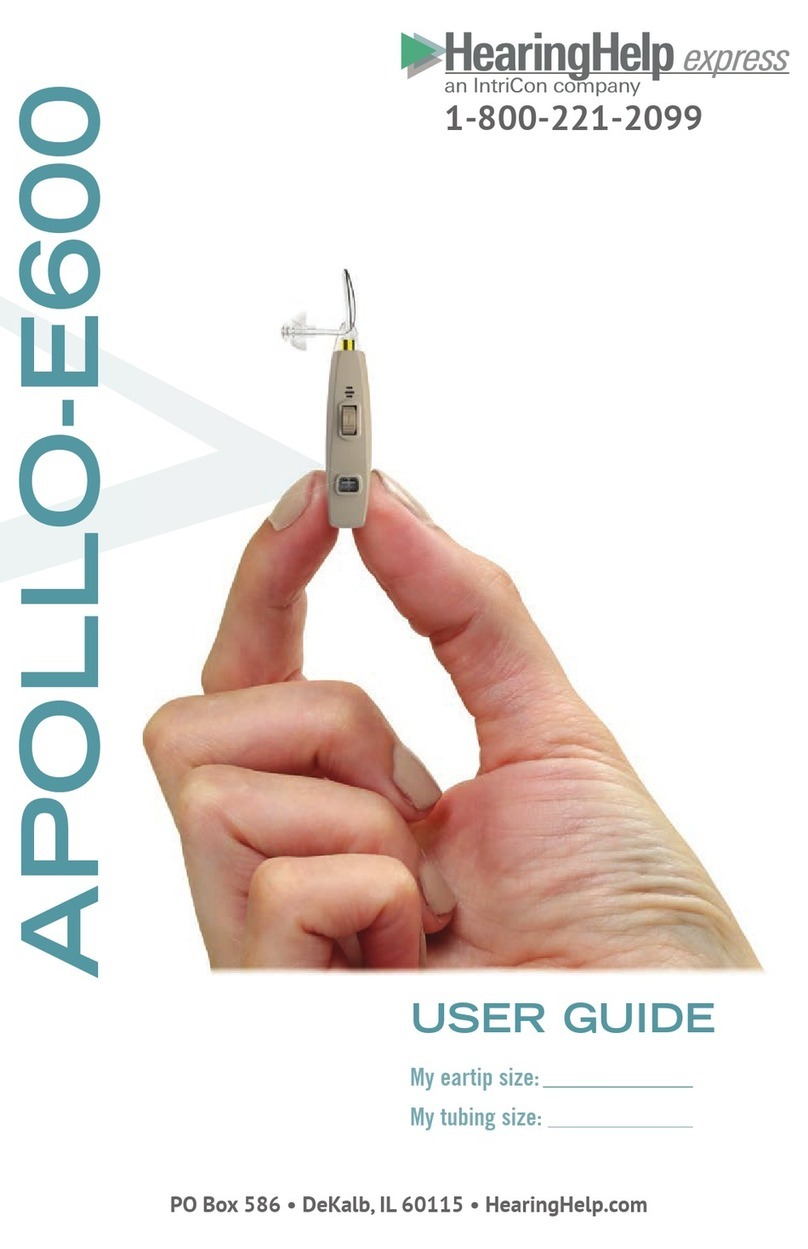
Hearing Help Express
Hearing Help Express Apollo-E600 User manual
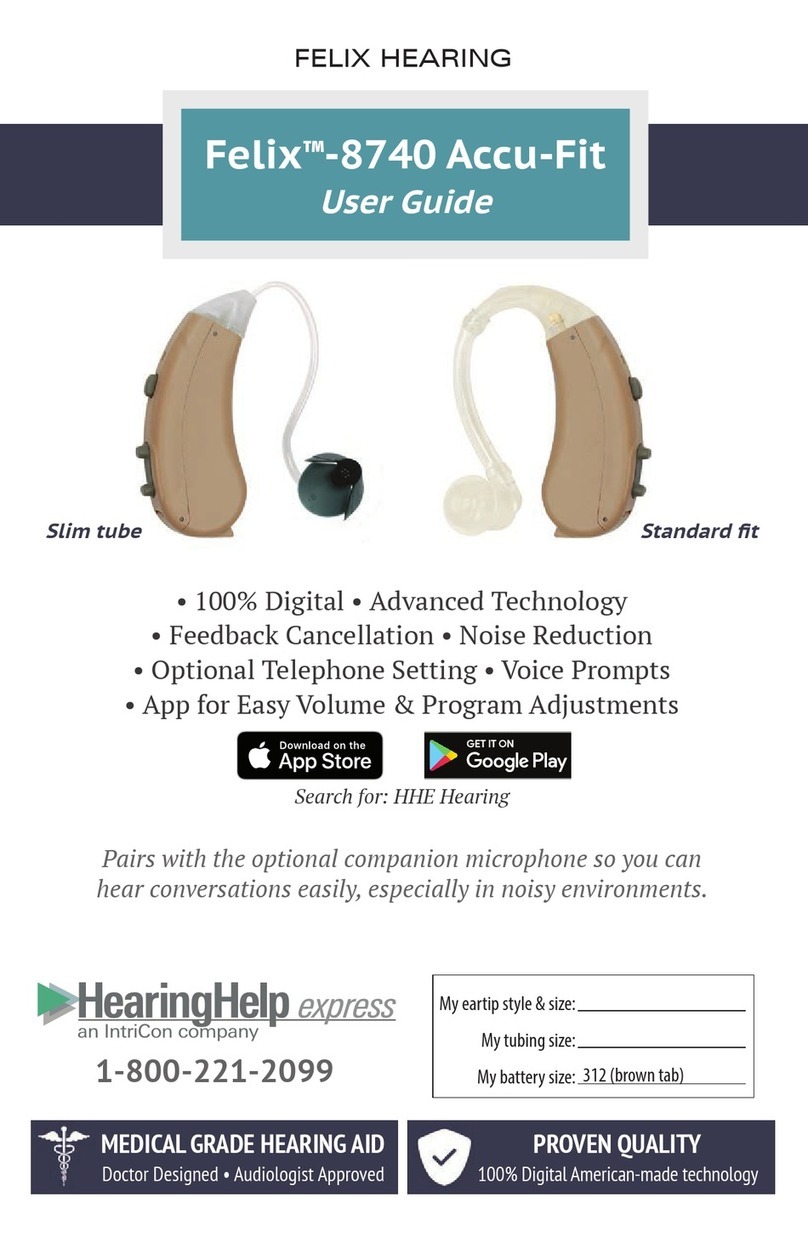
Hearing Help Express
Hearing Help Express Felix-8740 Accu-Fit User manual

Hearing Help Express
Hearing Help Express EarMate-4330 Diamond User manual
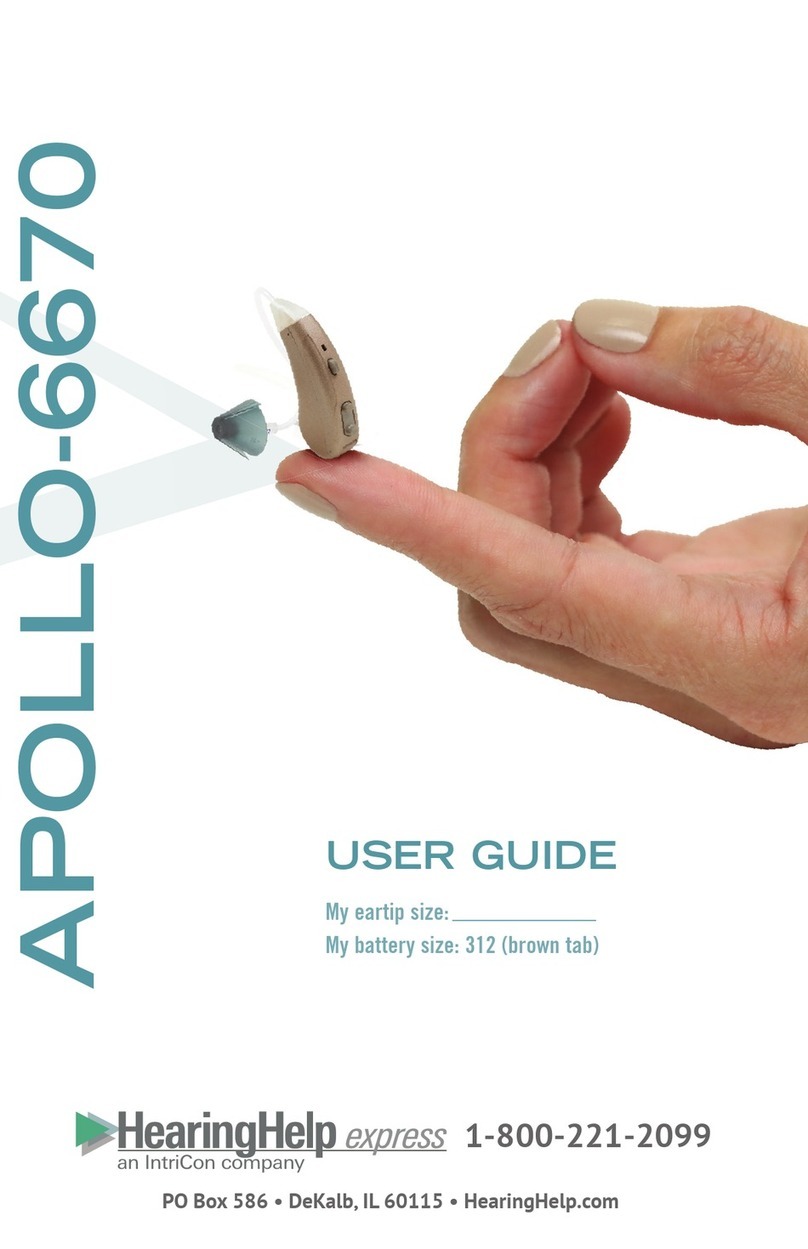
Hearing Help Express
Hearing Help Express APOLLO-6670 User manual
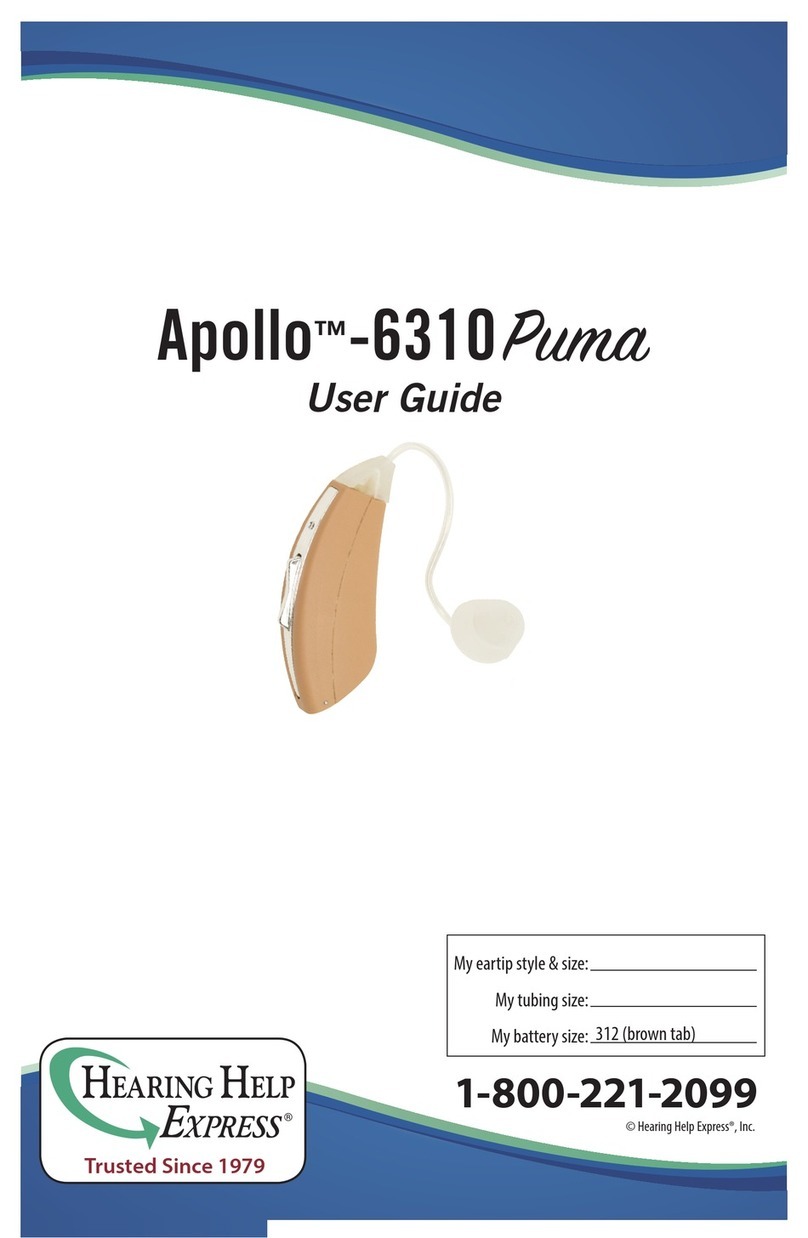
Hearing Help Express
Hearing Help Express Apollo-6310 Puma User manual
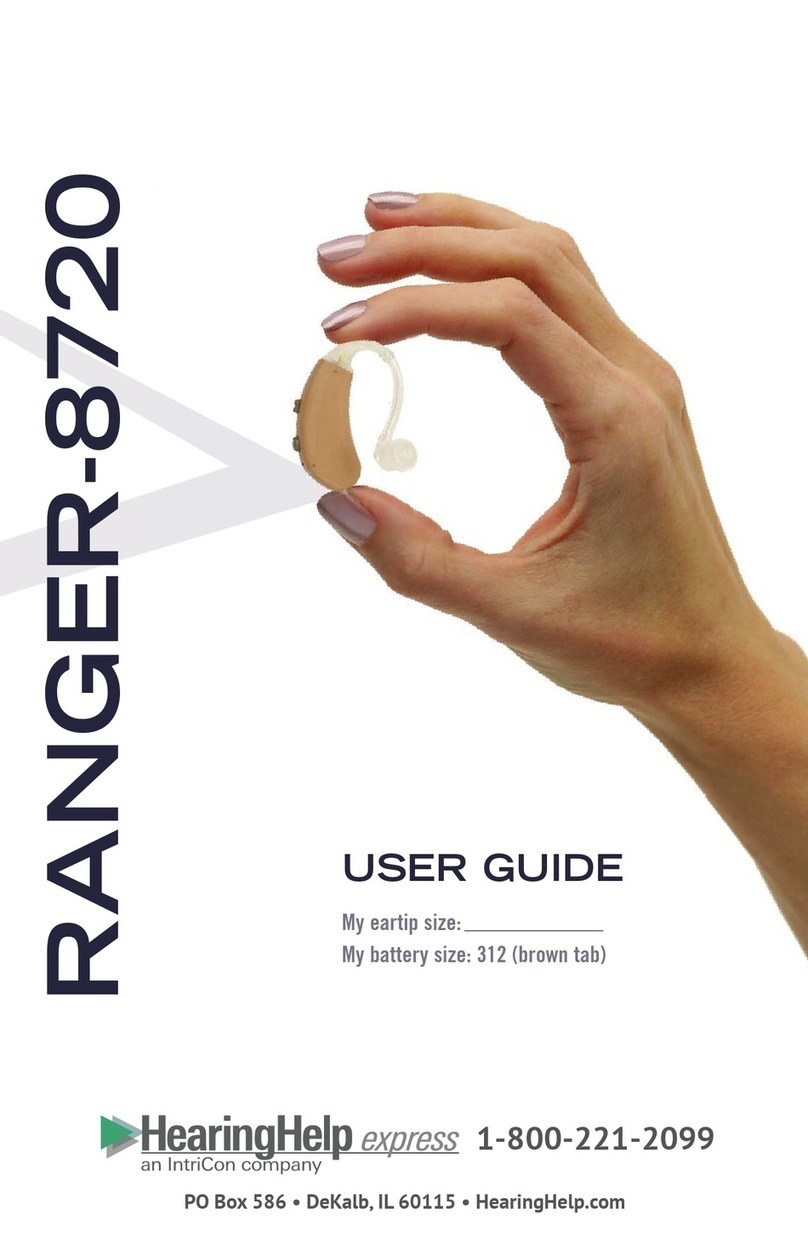
Hearing Help Express
Hearing Help Express RANGER-8720 User manual
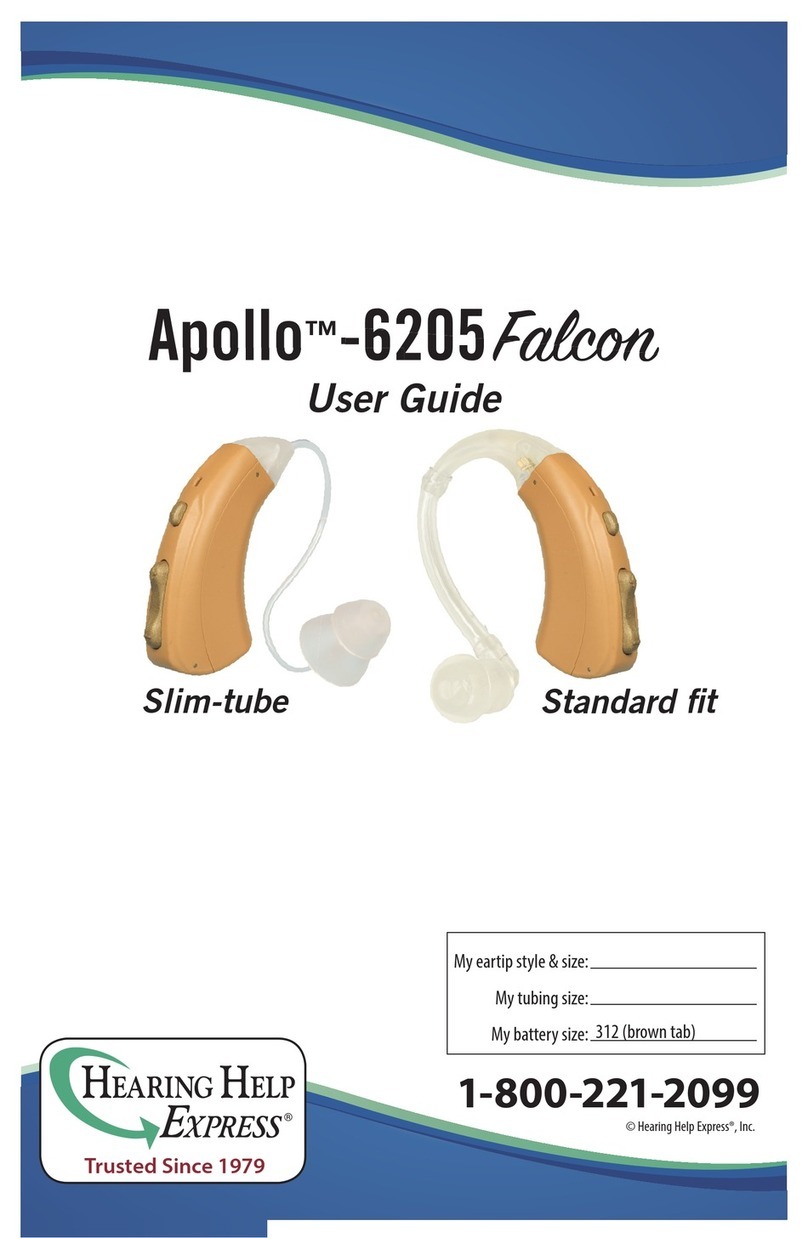
Hearing Help Express
Hearing Help Express Apollo-6205 Falcon User manual

Hearing Help Express
Hearing Help Express Apollo-E600 User manual
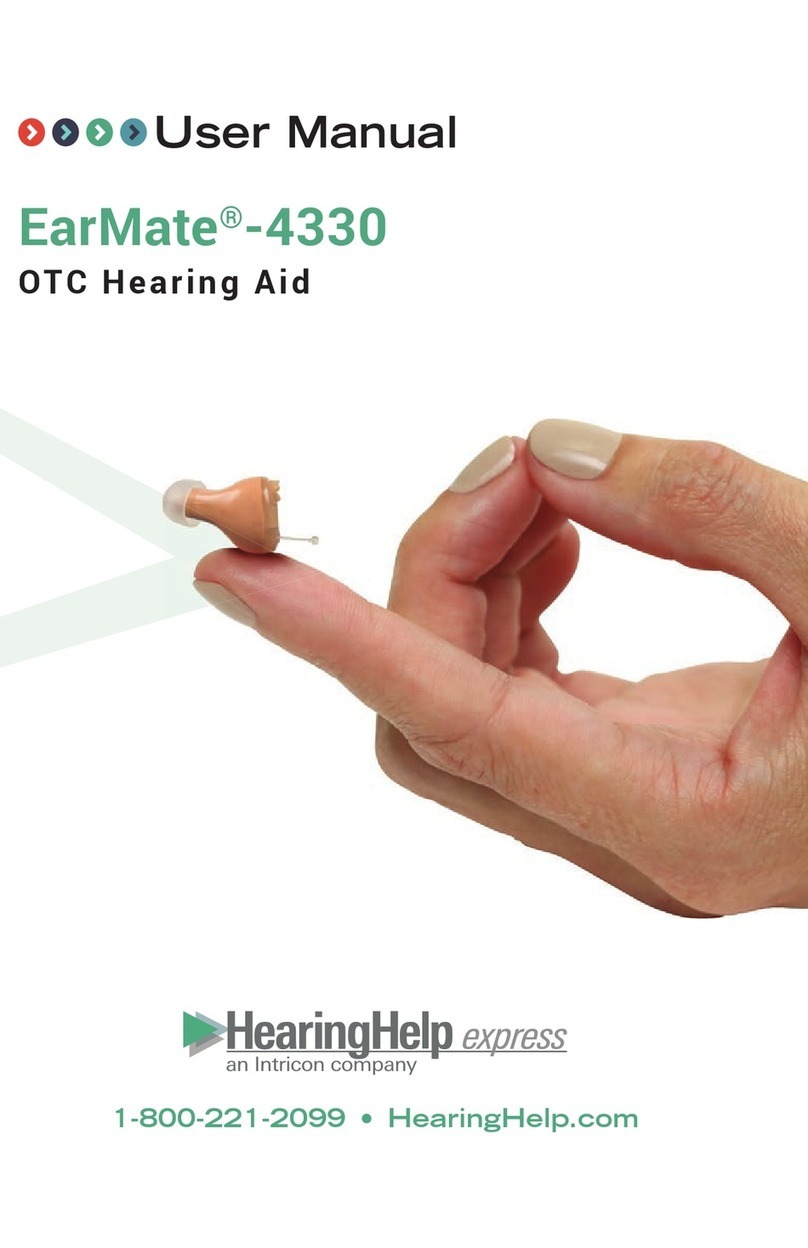
Hearing Help Express
Hearing Help Express EarMate-4330 Diamond User manual
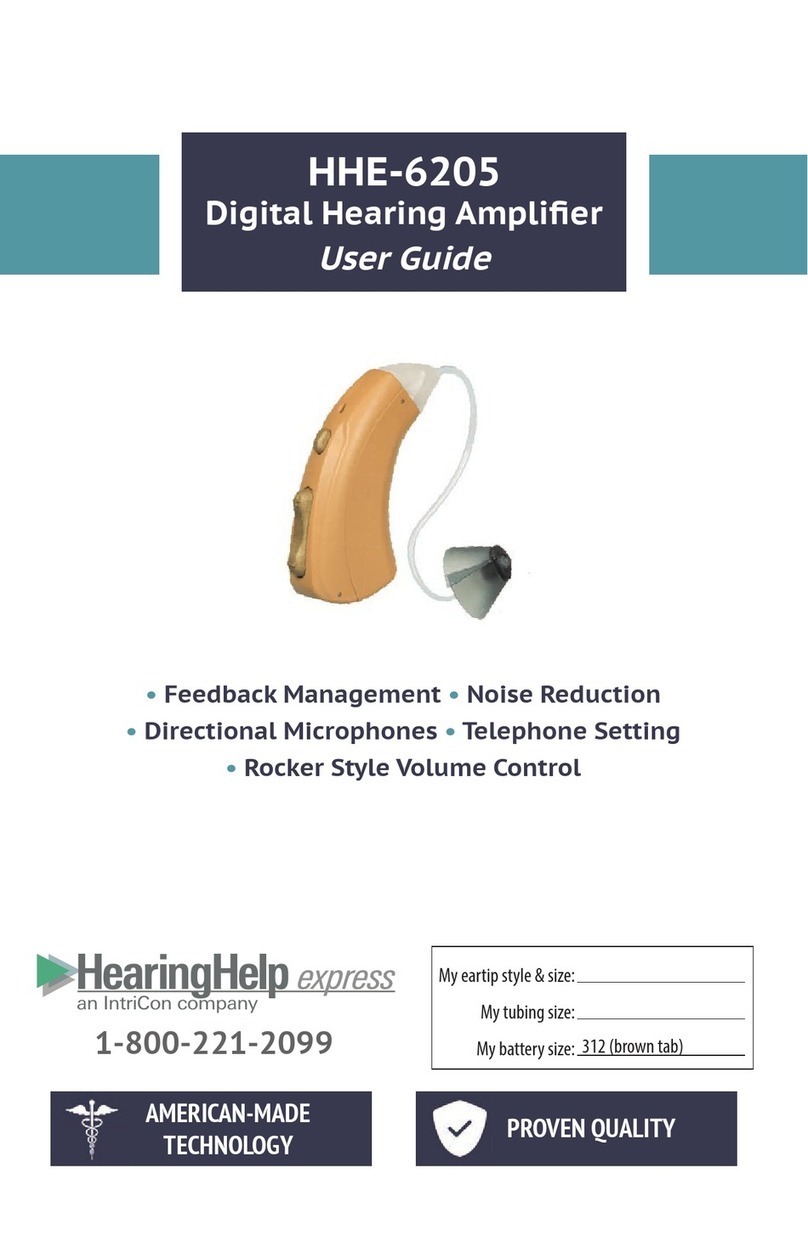
Hearing Help Express
Hearing Help Express HHE-6205 User manual
